Reviews & Articles
玩偶屋的故事: 君士坦丁的戲謔世界 ∣ The Story of a Dollhouse: The Satirical World of Konstantin Bessmertny
Oscar Hing-kay HO
at 10:03am on 14th June 2017
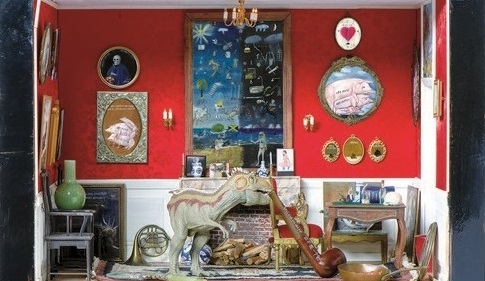
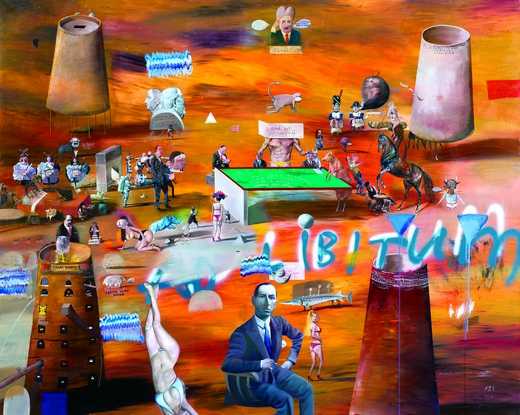
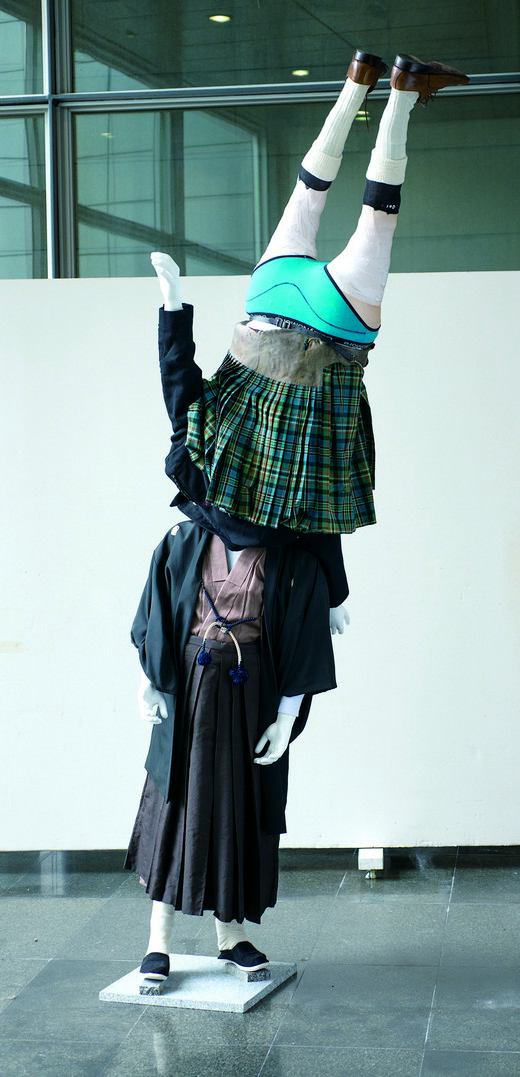
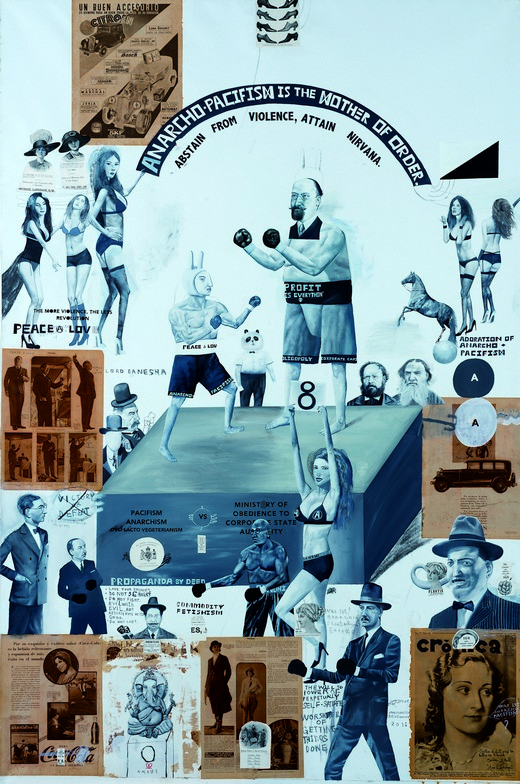
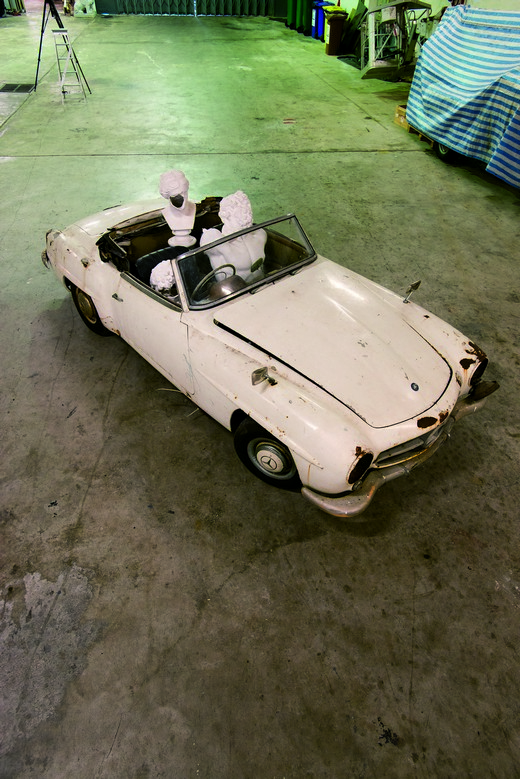
Captions:
1. 微型展覽玩偶屋,裝置:混合媒材,2014 ,藝術圈子像是一個巨型商場,這件事並不是甚麼秘密:裡面有販賣著名牌的大機構;大型藝術博覽扮演向參展人或藝術機構出租場地的出租公司,而且祇做能賺錢的生意。這作品雖然僅佔60x50cm的空間,卻可容納幾十件藝術品,更附有放大鏡用來參閱迷你價格表和目錄。Small Show Doll House, Installation: mixed media, 2014. It is no conspiracy that the art world resembles one large shopping mall where top ten art corporations sell and exhibit top ten art brands. Art conventions become real estate companies that lease space to exhibitors and Art institutions. It only serves people and organisations which it can profit from. Small Show Doll House, on the other hand, only takes up 60x50cm floor space and can display dozens of miniature artworks. The price of each work could be seen with the help of a magnifying glass on a miniature price list. A miniature catalogue is also available.
2. 即興,布本油畫, 2016,波希的畫作中對幾種動物的描繪,引起了這次自由即興——關於形式和敘事的隨興、無拘束實驗。Ad Libitum, Oil on canvas, 2016. A freestyle improvisation triggered at first by the depiction of several creatures in the work of Bosch, then it became a completely unregulated and spontaneous experiment in forms and narrative.
3. 東西之遇:璧合珠連,裝置:混合媒材,2016,這句英國反對蘇格蘭獨立的宣傳口號荒謬地加諸在“東西方”這個被濫用的概念上。Better Together. E Meets W. Series. Installation: mixed media, 2016. Our modern fossil-fuelled civilisation is represented by a completely decayed 1964 Mercedes Benz SL180 and remains from Classical Antiquity in the form of plaster casts and broken marble copies of Greek sculptures.
4. 不害以得解脫,布本油畫及拼貼,2016,關於托爾斯泰及甘地等人倡導的非暴力抗爭哲學,追求社會進步和瓦解國際戰爭集團的即興作品。“Abstain from Violence, Attain Nirvana”, Oil& collage on canvas, 2016. Improvisation son non-violent resistance philosophy advocated by prominent figures like Tolstoy and Gandhi for social improvement and dismantlement of the global warmachine.
5. 兜風,裝置:汽車/混合媒材 ,2016 ,一輛完全腐朽的一九六四年SL180平治房車,跟一些從古典時期遺留下來的破碎石像石膏複製品放在一起,以代表我們這個用化石燃料驅動的現代文明。Ride. Installation: car & mixed media, 2016 , Ourmodern fossil-fuelled civilisation is represented by a completely decayed 1964 Mercedes Benz SL180 and remains from Classical Antiquity in the form of plastercasts and broken marble copies of Greek sculptures.
© All photos courtesy of Macao Museum of Art and the artist Konstantin Bessmertny 澳門藝術博物館及藝術家君士坦丁
(Please scroll down for English version)
澳門是間玩偶屋。君士坦丁喜歡製作玩偶屋,也喜歡嚴肅地遊戲於玩偶屋內。
玩偶屋是個虛擬的私人世界,也是慾望的反映,那是個從現實中收集,透過想象堆砌出來的空間,是一己渴望擁有的再加上想象的世界,被壓縮在那親密空間內。現實中拿不到的,都在這溫馨華麗的房廳裡得以落實。玩偶屋有製造擬似現實的欺騙能力,觀看時像是走進另一現實空間,如果沒這份現實感,玩偶屋便未能發揮它的應有功能,把觀者帶進自己渴望移居的另一空間內。
“好奇櫃”(Cabinet of Curiosity)這普遍被視為西方最早期的博物館,其實也像間玩偶屋。十七世紀歐洲流行的“好奇櫃”,是個人把各種有趣小東西,包括小畫作、素描、犀牛角、獅子毛,寶石、貝殼,和被人騙了還不知的假東西如美人魚標本等,統統放在一起。這是個航運商貿業開始興旺,也是對科學感興趣的年代,歐洲人突然間發現外邊還有萬千世界,亞洲、非洲、美洲,有種文化、各類奇珍異獸。“好奇櫃”就是個私人空間,把真的、假的,從全世界或以為是全世界收集回來,可以是根據自行擬造的系統,也可以是全無結構體系的錯亂拼合,建構擬似科學的想象世界。真與假並存,現實片斷加上無邊的構想,走出來的是奇異、活潑多姿的半想象新世界。這奇幻世界,未必可看到十七世紀那商貿掠奪、強悍殖民的現實另一面。我們沉迷的,是那歡樂熱鬧的奇幻倣真世界。
澳門也像所大玩偶屋,一個把全世界都帶進去的豪華“好奇櫃”。在這裡可以見到縮小了的虛擬歐洲小城、意大利古建築、假天空下的威尼斯運河和貢多拉,加上穿十八世紀歐洲服飾的菲律賓歌劇唱家,還有那大幅縮短了的巴黎艾菲爾鐵塔…。布景板世界收集各地景觀名勝,遊人爭相在這些歐洲景點前拍照,興奮地留下像是曾經訪歐的紀錄,畢竟祇要加點想象力便可算是真的了。濃郁歐陸風情,給訪客特別是大陸遊客美好的外遊投想,正如十七世紀時歐洲人對亞洲的遐想一樣。
但現實又從來不是那麼黑白、中西分明,澳門這中國最早開放予歐洲的城市,確實留下不少歐洲人的歷史和風貌,始於十六世紀中葉的龍蛇混雜進出口小港,如君士坦丁所說,是“傳教士、冒險家、研究員、詩人以至藝術家的龐大交匯”,各方人物各有其原因在此聚集糾纏,它曾經有其獨特優雅的文化,也有強悍貪婪的商旅故事。這個葡式建築交錯於中國樓房的城鎮,起初的出現就是為了發財,在十六世紀的商貿航運,是個風險極高的冒險,根本就是一場賭博,而這被金錢迷惑的行業,又吸引各方的冒險家。在一首遠航貨船上,除領航的歐洲人外,往往也結聚了中國、日本、菲律賓、南美、非洲的各類人種,有的為了金錢權力、有的為了傳教,或好奇冒險,也有逼於無奈,背景迥異,各有其慾望,萬千世界共聚一船,這就是早年的遠航貿易世界,也是澳門的寫照。幾百年後澳門又再發展賭博,娛樂業的金錢、色慾交替的場面,對遠道從俄羅斯而來的君士坦丁來說,澳門是個極奇怪的經驗,而這奇怪經驗對一個有深厚歐洲文化藝術傳統背景的藝術工作者來說,在思想以至創作上的沖擊肯定十分巨大。
曾接受嚴謹歐洲傳統美術學院訓練的君士坦丁,作品有在當代藝術工作者中已逐漸消失的傳統學院的藝術技法,再加上過去的成長和學習經驗,不單在技法和思維上仍帶濃厚歐洲色彩,西方歷史中的一些重要象徵符號和人物,包括思想家,宗教人物或皇室政客,充斥其思想脈絡。但這些代表嚴肅的思維、信仰或政治權威標誌,在備受現代的淘汰和社會流行、消費主義的衝擊,已被遺棄於歷史中,其存在顯得脆弱甚至再無意義。澳門正是這個既有豐富文化、歷史淵源,同時又在演變成為發財、消費和物質享受的慾望大展場。
君士坦丁的玩偶屋,手工細緻精美,單是製作上已經迷惑觀眾,但這又不是完全美好的溫馨空間,當中隱藏點點嘲弄。華麗廳堂擺上名畫,原本是品味修養的反映,卻又變成售賣藝術的交易場。有時候玩偶屋內是電影《教父》的場面,影射金錢、權力的現實。君士坦丁喜歡插入嘲諷去擾亂那虛擬想象。玩偶屋中的繁華,往往滲出了不太美麗的現實。像是對那如舞台場景的賭博廳背後的燦爛、浮誇甚至腐敗作批判,當中也包括對藝術工作者的批判。君士坦丁往往進一步干擾場景,把與流行、消費和媚俗文化拼貼進去扮作典雅的場面,有時候是加強其荒謬性,有時候是個批判,而其深厚的繪畫技法,更加強對傳統、現實的戲謔。
丹麥著名劇作家易卜生(Henrik Ibsen)的名劇《玩偶屋》中,女主角娜拉走出那虛假空間進入現實世界,是個個人解放。但即使走出君士坦丁的玩偶屋,那怪異、不配合甚至矛盾的組合,現實加虛擬、精緻與流行媚俗文化並存的荒謬世界仍然存在,祇不過是更大更複雜的玩偶屋。歷史、現實、虛假與想象的交替凝聚並存。例如宗教神廟的獅子雕像,身上的有戲玩歷史人物如馬克斯、弗洛依德再加裸女的蒙太奇、電影的虛擬世界和字幕錯配、時空倒轉的種種荒誕,以至曾經豪華的汽車內那危險的閃電,現實生活都是脫節卻又走在一起的。
戲謔是君士坦丁的創作核心,澳門這最早撮合東方與西方文化匯聚的城市,亦成其創作主題。《東西之遇:老樣子》中日本戰士站立的十七世紀歐洲房間,是個風馬牛不相及的相遇;《朕即國家》展示中與西、過去和現在中,色情及權力的彆扭連結。不過也不應把他所有作品都視作嚴苛批判,有時候也祇是頑皮戲玩,例如那沒穿褲子的貢多拉船夫。
不難理解何以君士坦丁鍾情十五世紀荷蘭畫者波希(Hieronymus Bosch)的作品。君士坦丁的作品,是波希名畫《俗世樂園》(The Garden of Earthly Delights)的現代版,當中同樣有各種怪誕人物、動物以至妖獸,進行形形式式、情慾盡顯的交合和交易。那由兩幅半圓形組的大圓形畫,更是澳門這“俗世樂園”,或君士坦丁所謂“最拙劣文化倒退的俗豔之樂”的寫照。其中的《澳門戰役》部份,是從歷史出發,追索澳門兩場重要戰役,利用荷蘭與葡萄牙於十七世紀初的澳門爭奪戰,呼應二千年初的開放賭場的另一歷史性戰役,而在這兩場落實澳門歷史面貌的戰役的另一邊,轉移到更大的文化和社會生活戰役。在不斷重覆地旋轉交替的巨畫另一邊,是名為《貪.愚.畏.惰》的半圓畫,是由《澳門戰役》伸延,更遠且闊地展示人類的貪婪、愚蠢、恐懼和懶惰。在澳門這璀璨俗豔的玩偶屋內,我們看到自己和我們社會的縮影。
The Story of a Dollhouse: The Satirical World of Konstantin Bessmertny
Oscar HO
Macao is a dollhouse; Konstantin Bessmertny is absorbed in making dollhouses and playing intently in them.
A dollhouse is a personal simulated world of desires. It is constructed with one's imagination, aspirations and fantasies about the real world. These components are compressed into this snug space: what cannot be acquired in real world is made true in this cozy and sumptuous living room. A dollhouse is a make-believe world transporting viewers into an alternative reality. Without make-believe, a dollhouse would fail to carry viewers to a better world.
In the West, cabinet of curiosity was the early form of museum, and it functioned similarly as a dollhouse. Cabinet of curiosity came into fashion in the 17th century. Collectors put together a range of objects, such as little sketches, rhino horns, locks of lion hair, precious stones, seashells and fabricated mermaids corpses that deceived unsuspecting collectors. It was the beginning of a golden age of maritime trade and scientific inquisitiveness, when Europeans started to realise that there was a world beyond their own: Asia, Africa, America and other cultures along with different exotic creatures. Cabinet of curiosity was a personal space that brought together what was genuine and counterfeit, truly or dubiously cosmopolitan. It could be a well-ordered collection or a disorganised assemblage. It was an imaginary world of quasi-science, where fact and fiction coexist. It was a vivid strange new world concocted out of fragments from reality and limitless imagination. Through it, one cannot necessarily see the seamy side of fierce trade competition and aggressive colonisation. People were above all dazzled by the bustling and magical side of this surreal world.
Macao is like a big dollhouse: a luxurious cabinet of curiosity with a combination of everything from the world. Within it one can see miniaturised replicas of European towns, classical Italian architecture, Venetian canals and gondolas underneath an artificial sky, Filipino opera singers in 18th-century European costumes, and a drastically shrunken Eiffel Tower. These backdrops show attractions from various places. Tourists jostle to take pictures in front of these European landmarks and excitedly record their “travels in Europe”. With a little imagination, it can almost convince. The heady European ambience induces, especially among Mainland Chinese visitors, the intriguing feeling of being abroad, which is not dissimilar to the fascination Europeans held for Asia in the 17th century.
In reality things are not, however, distinctly divided into East and West. Macao was the first Chinese city open to the Europeans, who left their history and customs. Beginning in the mid-16th century, Macao became a boomtown that was, as Konstantin put it, “a large crossroad for missionaries, adventurers, researchers, scholars, poets and artists.” People from different places came together for their own reasons. A unique and refined culture emerged in Macao. There were also trading stories of aggression and greed. This city, where Portuguese architecture blended with Chinese dwellings, was created at first as a place for people to make a fortune. Maritime trade in the 16th century was a risky business, which is similar to gambling. It attracted many adventurers to try their luck to hit the jackpot. Onboard a trading ship, apart from the Europeans who sailed it, there were people from China, Japan, the Philippines, South America and Africa. Some were there for the wealth and power; some were there as missionaries; some were there for the adventure and some had no choice. All passengers came from different backgrounds and had different wishes. The whole world was onboard this one ship. This was an illustration of early maritime trade and also of Macao itself. Several hundreds of years later comes a world that indulges in gambling and entertainment. To Konstantin who came all the way from Russia, it must be the most bizarre experience. Since he came from a rich European cultural and artistic background, this experience must have made a great impact on his way of thinking and creativity.
Konstantin underwent a rigorous traditional European artistic training. His strength lies in his traditional artistic techniques, which are in decline among contemporary artists. Together with his upbringing and academic experience, he possesses strong European characteristics in his techniques and ways of thinking. Important icons and figures from the Western history, such as thinkers, religious figures, royals and politicians, also form the artist’s background of thought. These figures, who represented high-minded ideas, beliefs and political authorities, are impacted and eliminated by the modern society’s popular culture and consumerism. Their existence was rendered feeble or even useless and left behind in history. Macao itself is a show house that consists of a rich culture and history, and at the same time is evolving into a place for fortune making, consumerism and materialistic overindulgence.
Konstantin’s dollhouses are delicately crafted; the craftsmanship itself is fascinating enough. They are however not entirely welcoming, as they are laced with satire. Displaying paintings in a grand living room is supposed to be an act of good taste, yet here the room became a marketplace for art. The scene from “The Godfather” in another dollhouse mocks the reality of wealth and power. Konstantin likes adding ridicule to interrupt viewer’s fantasies, with ugly truths seeping into the extravagance of the dollhouse. They are like criticisms on the glamour, excess and corruption, and the criticisms extend to artists themselves. Konstantin interferes with the elegant scene by adding popular culture and kitsch into the mix, enhancing the absurdity and severity, and his masterly painting techniques further intensify his satire on traditions and the status quo.
In the renowned playwright Henrik Ibsens’s “A Doll’s House”, the main protagonist Nora escaped from an artificial world into a real new world. It was an important personal liberation. However, even if we escape from Konstantin’s dollhouse, the queer discordant contradictory world still surrounds us. That world of absurdity, where real and simulated, refined and vulgar coexist, is just a larger and more complex dollhouse. It is where history, reality and imagination overlap.
Portraits of historical figures, such as Marx and Freud, along with an array of nude women, were jokingly drawn on the body of a temple lion sculpture; simulated film worlds with out-of-sync subtitles; the absurd non-linear movement of time; a once grand automobile with dangerous lighting inside: all of which are fragments put together from everyday life.
Satire is at the core of Konstantin’s work. As the first city that brought together the East and West, Macao also became one of his subject matters. In “E. Meets W. Same Shit”, a Japanese samurai stood in a 17th-century European style room. It is an unlikely encounter; “L’Etat C'est Moi” shows the twisted interplay between sex and power in the East and West, past and present. However not all of his works are harshly critical, sometimes they are only playful parodies, like the gondoliers without trousers.
It is not difficult to understand why Konstantin admires the work of the 15th-century Dutch artist Hieronymus Bosch. Konstantin’s work is a modern version of Bosch’s famous work “The Garden of Earthly Delights”, in which there are all sorts of weird characters, beasts and monsters engaging in different carnal liaisons and intercourses. The huge circular painting that is combined by two semi-circular paintings, is the depiction of Macao as “a garden of earthly delights”, or as Konstantin put it, “the delight of opulent kitsch with the silliest cultural throwback of all times”. In the “Battle of Macao” part, the artist traces back to the two most important battles in the history of Macao. The 17th-century mercantile competition between Holland and Portugal echoes the liberation of Macao’s gambling industry in the early 2000s. On the other side of the two defining battles of Macao is a grander battle in culture and social life. The other half of the circular painting is called “G.S.F.S. (Greed, Stupidity, Fear and Sloth)”, which is an extension of “Battle of Macao”. It extensively shows us humanity’s greed, stupidity, fear and sloth. In this glamourous yet vulgar dollhouse in Macao, we can see a reflection of our society and ourselves.
Link for further info:
Ad Lib──君士坦丁近作展 @ 澳門藝術博物館
AD LIB- Recent Works by Konstantin Bessmertny @ Macao Museum of Art
原文刊於《Ad Lib──君士坦丁近作展》展覽場刊,2016年。
This review was first published in AD LIB- Recent Works by Konstantin Bessmertny exhibition catalogue, 2016.
